Events of Tuesday, 25th July 2017
This time, the single-unit 'Bubble Car' 55005 was used for four round trips from Shackerstone to Shenton, leaving Shackerstone at 11:00, 12:30, 14:00 and 15:30.
During my daily examination before we started, I'd noticed brown staining on the corner pillar at the south end of 55005 which I initially thought was the result of a previous 'bird strike'. Once I'd brought the unit into the platform at Shackerstone, I attempted to remove the marks with detergent, without success. Closer inspection suggested that the culprit was fruit juice from wild berries growing near the track. There had been a lot of rain, encouraging wet branches on lineside trees to lower themselves, potentially striking the train.
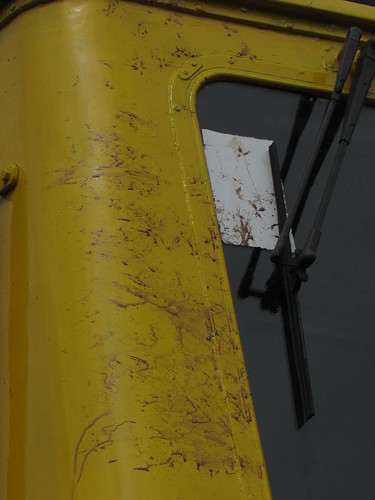
Staining on the corner pillar at the south end of 55005.
Although it was not raining on the Tuesday, there were still a few places along the line where sodden branches hit the train. Keeping the railway clear is a major task, akin to the proverbial 'painting the Forth Bridge'. Regular efforts by volunteers are needed in the growing season. Other than a few 'slaps' from branches, we arrived at Shenton without incident.
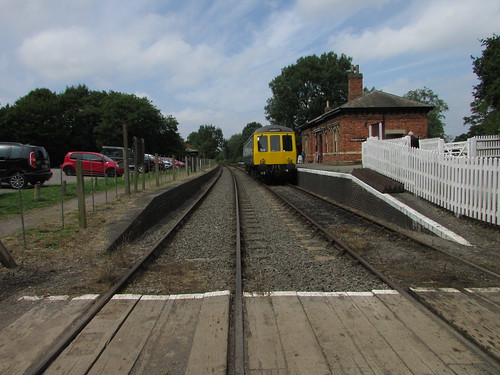
55005 at Shenton, viewed from the foot crossing.
From time to time, the sun emerged, allowing me to photograph Tony, the Guard (who is also a DMU Driver) and Bernard, on that day acting as Travelling Ticket Inspector (TTI).
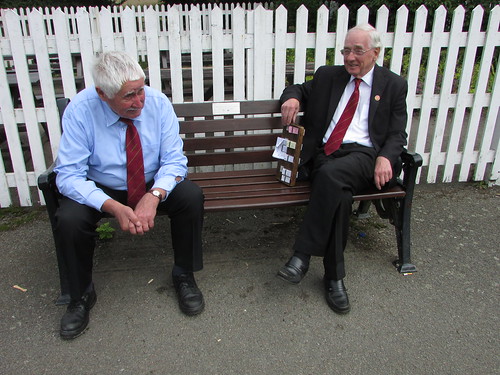
Tony (Guard) and Bernard (TTI) at Shenton.
The only problem during the day was an intermittent loss of control air pressure caused by a sticking 'E.P. valve'. The 'E.P. valves' are electro-pnuematic solenoid-operated valves which remotely control engine throttles, gear-changing and the final drives mounted on the powered axles. Tony and I opened up the suspect control box but failed to locate the occasional fault.
Events of Sunday, 30th July 2017
I was rostered to drive regular performer 'Cumbria' but, on Saturday night, I had a text from Steve A. who was booked to fire on Sunday saying that 'Cumbria' had failed with injector problems and we would be using 'Sir Gomer'. It had been some time since I'd driven resident engine 'Sir Gomer', so I welcomed the opportunity to re-acquaint myself with the locomotive.
'Sir Gomer' is a six-coupled Peckett, class OX1, works number 1859 of 1932 with two 18 x 24 inch outside cylinders and 3 feet 10 inch diameter wheels. Nominal weight is given as 34.5 tons. The locomotive worked at Mountain Ash Colliery until preservation in 1981, before moving to the Battlefield Line in 2001. There's a little more history (and an explanation of the name) on 'Wikimedia Commons' here. I think that back in 2001 the locomotive was in plain green livery but, more recently, she carried a handsome lined-out green. Her last repaint was in unlined blue.
Prior to working the service trains, we had a 'Gold Footplate Experience', where the trainee driver has one round trip to Shenton light engine, followed by a second round trip hauling the passenger train, carrying the trainee's family and friends. Whilst our trainee was on the footplate, it remained dry although overcast and he said that he thoroughly enjoyed the experience. There are a number of posts in this blog which talk about driving experience courses at different sites.
Because of a problem with the Buffet Car 'Jessie' all the service trains during the day departed from and arrived in platform 1, to ease the problem of replenishing the water supply. It was still dry when we set off with the first train, about ten minutes late, but later in the day, we had a number of heavy rain storms. I normally drive leaning out of the cab, for better visibility ahead and I had little option with 'Sir Gomer' - I'm not very tall and I found the spectacle glasses set too high up to keep a good look-out. In any case, when moving in driving rain, the spectacle glasses give a very limited view, so I resigned myself to getting wet. But, even leaning out, it's not ideal with rain sluicing towards you (I remembered my mantra - "Anyone can work on an engine in good weather, it takes footplatemen to do it in bad weather").
We managed to make up the lost time and finished the day very close to 'right time'. Although it remained overcast, it didn't rain all the time and I enjoyed the day. Incidentally, 'Sir Gomer' was sporting a loaned chime whistle which I believe originally graced a South African locomotive. I normally disapprove of non-authentic fittings, but I have to admit it did rather grow on me!
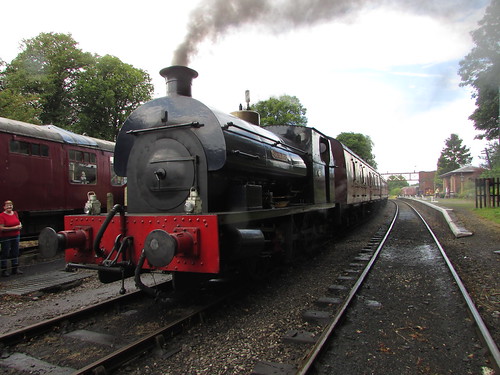
'Sir Gomer' in platform 1 at Shackerstone.
Events of Wednesday, 2nd August 2017
After signing in and reading the Operating Notices, I walked to the DMU Siding and discovered that the diesel railcars had been 'swopped around', so that we would be running with the 2-car set (51131/51321). There had been heavy rain (which returned during the day) and I was warned that a tree had come down the previous day so I proceeded with caution on the first trip in case there were any new obstructions. Other than the front corner of the driving cab receiving a slight 'slap' occasionally from a branch, all was well.
I hadn't realised that it was exactly 25 years since passenger services returned to Shenton in 1992 (although I'd started my career in preservation in 1988, I didn't join the Shackerstone Railway Society until after 1992). Dave Weightman, the Guard, however, remembered bringing a table from home on the inaugural day which he set-up on the platform at Shenton (there was no station building then) and from which he sold tickets!

Dave Weightman (Guard) at Shenton, 25 years after the public re-opening of the station, near the spot where he set up his ticketing table.

The Summer 1992 copy of 'Shackerstone News' had this article about passenger services returning to Shenton.
I'm afraid there was no celebration in 2017, no bunting, but a member took a picture of Dave, Jan and the DMU.
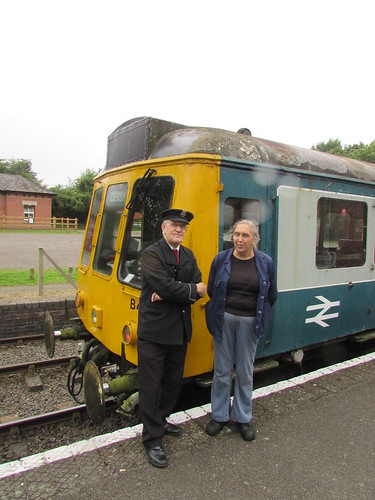
Dave Weightman (Guard) and Jan Ford (Driver) at Shenton, 25 years after the public re-opening of the station.
The well-proportioned and elegant Shenton Station Building originally served as the Ticket Office at Humberstone Road Station, Leicester. In 1992 it was redundant and Leicestershire Country Council, with help from a number of organisations, took it down, and re-erected in in its present location.

The redundant building in Leicester, prior to dismantling.
The roof was removed and slates were reclaimed. Roof timbers were not good enough to re-use and were replaced. The walls were dismatled at section at a time, the bricks cleaned and palletised for transport to Shenton. By February, 1993, the Humberstone Road site had been cleared.
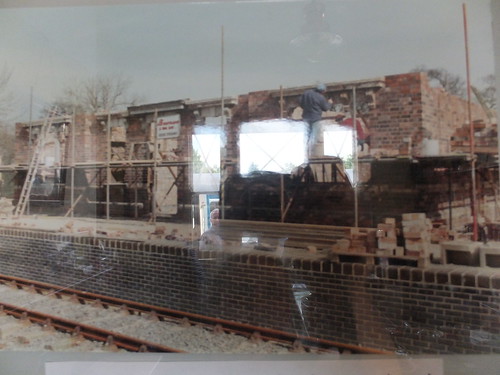
The building in course of re-erection at Shenton.
By April 1993, the building at Shenton was ready for tiling.

Shenton Station Building, shortly after completion.
On the final journey of the day from Shenton back to Shackerstone, it was agreed to stop in a few places to allow Dave to 'lop' overhanging branches. Another interesting day, well-supported by passengers.
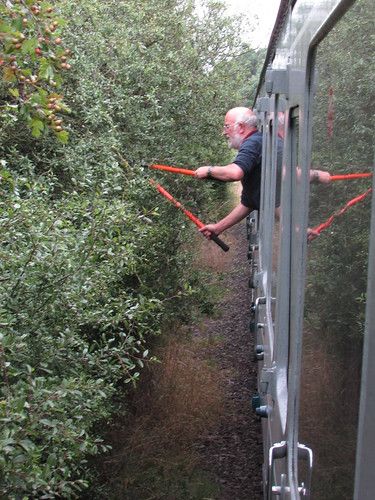
Branches being 'lopped' by Dave.
Related posts on this website
To see all my posts about DMU at the Battlefield Line, select Label 'DMU'
or click here.
To see all my posts about the Battlefield Line, select Label 'Battlefield Line'
or click here.
My photograph albums
Where necessary, clicking on an image above will display an 'uncropped' view or, alternately, pictures from may be selected, viewed or downloaded, in various sizes, from the albums listed:-
DMU at the Battlefield Line (2).
'Sir Gomer'.
DMU at the Battlefield Line (3).
Shenton Station Building.
All my Battlefield Line albums.
